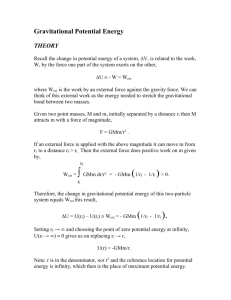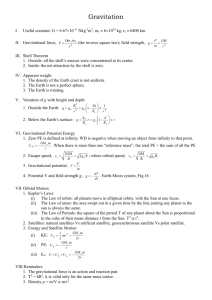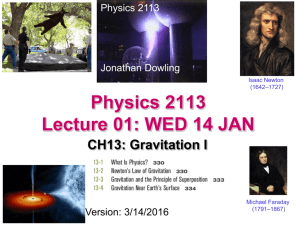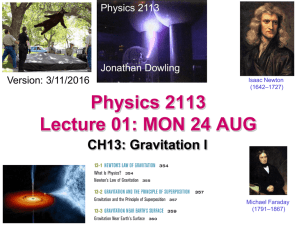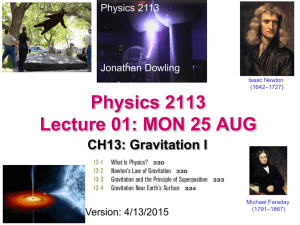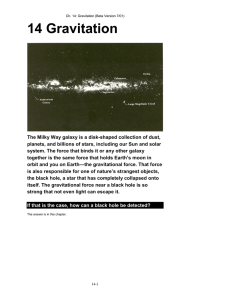Chapter 13
advertisement
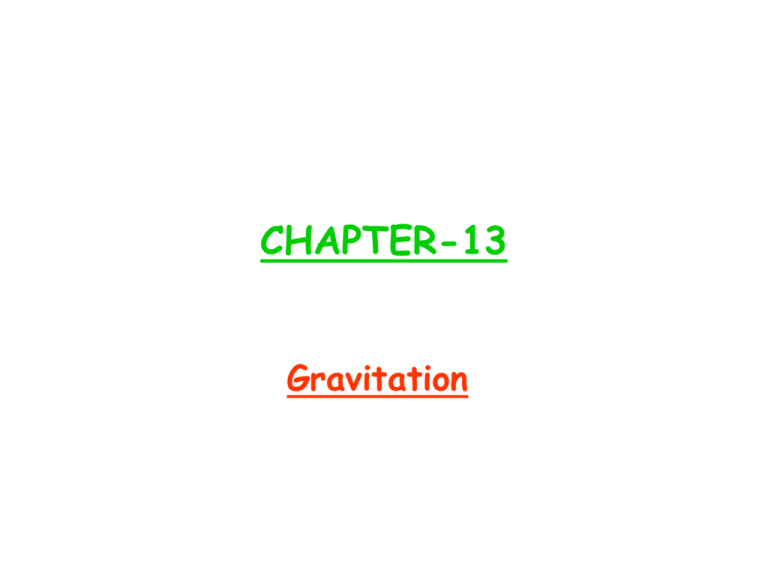
CHAPTER-13 Gravitation Ch 13-2 Newton’s Law of Gravitation Newton's Law of Gravitation- a key in understanding gravitational force holding Earth, moon, Sun and other galactic bodies together Magnitude of gravitational force F between two mases m1 and m2 separated by a distance r: F=G(m1m2/r2) Gravitational constant G= 6.67x10-11 m3/kg.s Ch 13-2 Newton’s Law of Gravitation Shell theorem: A uniform spherical shell attracts a particle outside the shell as if all the shell mass was concentrated at the shell center For any particle located inside the shell, the net gravitational force between the particle and shell is zero Ch 13 Checkpoint 1 •A particle is to be placed , in turn, outside four objects, each of mass m: (1) large uniform solid sphere, (2) large uniform spherical shell, (3) a small uniform solid sphere, (4) a small uniform shell. In each situation, the distance between the particle and the center of the object is d. Rank the objects according to the magnitude of the gravitational force they exert on the particles, greatest first • all tie Ch 13 Checkpoint 2 The figure shows four arrangements of three particles of equal masses. (a) Rank the arrangements according to the magnitude of the net gravitational force on the particle labeled m, greatest first. (b) In arrangement 2, is the direction of the net force closer to the line of length d or to the length D. (1) (2) (3) (4) Fnet=Gm2(1/d2+1/D2)i Fnet=Gm2[(1/d2 )i+(1/D2) j] Fnet=Gm2[-(1/d2 )+(1/D2)]i Fnet=Gm2[-(1/d2 )j+(1/D2)i] (a) 1, tie of 2 and 4, then 3; (b) line d Ch 13 Checkpoint 3 In the figure her, what is the direction of the net gravitational force on the particle of mass m1 due to other particles, each of mass m and arranged symmetrically relative to the y axis? Net force downward along yaxis with all x-components cancelled out Ch 13-4 Gravitation near Earth Surface Principal of superposition of Gravitational force For n interacting particles, the net gravitational force on particle 1 due to other is F1,net=i=2F1i Gravitation near Earth Surface: Force of attraction between the Earth and a particle of mass m located outside Earth at a distance of r from Earth’s center; F=GmME/r2 but F=mag where ag is gravitational acceleration given by: ag= GME/r2 Ch 13-4 Gravitation Near Earth Acceleration of gravity g differs from g because: Earths mass is not uniformly distributed Earth is not a sphere Earth is rotating Analyze forces on a crate with mass m located at the equator FN-mag=-FR=-mv2/R=-mR2 But FN=mg then mg = mag-mR2 g = ag-R2 Ch 13-5 Gravitation Inside Earth For any particle located inside uniform shell of matter , the net gravitational force between the particle and shell is zero Ch 13-6 Gravitational Potential Energy Gravitational Potential Energy of two-particles system: Work done on the ball when the ball move from point P to a point at infinity from earth center W= F(r).dr= F(r)dr cos For =180 and F(r)=GMm/r2 W= R -F(r).dr=R -(GMm/r2)dr 2 =-GMmR (dr/r )= GMm[1/r]R W=0-GMm/r=-GMm/r Ch 13-6 Escape Speed Potential Energy and Force: Force F(r)=-dU/dr=-d/dr(GMm/r)=-GMm/r2 Negative sign indicates direction of force opposite to that increasing r Earth Escape Speed Minimum initial speed required at Earth surface to send an object to infinity with zero kinetic energy (velocity) and zero potential energy. Then Ki+Ui=mvesc2/2-GMm/R=0 vesc=2GM/R Ch 13 Checkpoint 4 You move a ball of mass m away from a sphere of mass M. (a) Does the gravitational potential energy of the ball-sphere system increase or decrease? (b) Is positive or negative work done by the gravitational force between the ball and the sphere? (a) U= -(GmM)/r [ U=0 for r= and U becomes more negative as particles move closer]. (a) U becomes less negative and it increases (b) Wg=-Wa negative Ch 13-7 Planets and Satellites: Kepler’s Laws Kepler’s Law of Planetory Motion: Three laws namely Law of Orbits, Law of Areas and Law of Periods Law of Orbits: All planets move in elliptical orbits , with the sun at one focus. Semi major axis a, semi minor axis b; eccentricity e, ea distance of one of the focal point from the center of the ellipse For a circle eccentricity e is zero Ch 13-7 Planets and Satellites: Kepler’s Law- Law of Areas Law of Areas: A line that connects a planet to the sun sweeps out equal areas in the plane of the planet’s orbit in equal time intervals; that is the rate dA/dt at which it sweeps out area A is constant Area A of the wedge is the area of the triangle i.e. A=(r2)/2; dA/dt = r2(d/dt)/2= r2/2 But angular momentum L=mr2 Then dA/dt= r2/2=L/2m Ch 13 Checkpoint 5 Satellite 1 is in a certain circular orbit around a planet, while satellite 2 is in a large circular orbit. Which satellite has (a) the longer period and (b) the greater speed T2=(42/GM)R3 Since R1<R2 then T1<T2 Longer period for satellite 2; (b) K=mv2/2=GmM/2R v2=GM/R Greater v for smaller R i.e R1 the greater speed for satellite 1 Ch 13-7 Planets and Satellites: Kepler’s Law- Law of Periods Law of Periods The square of period of any planet is proportional to the cube of the semi major axis of the orbit Considering the circular orbit with radius R (the radius of a circle is equivalent to the semi major axis of an ellipse) Newton’s law applied to an orbiting planet gives GmM/R2=mv2/R=m2/R GM/R3= 2=(2/T)2 R3/GM=T2 /42 T2 =(42/GM) R3 Ch 13-8 Satellites Orbits and Energy For an orbiting satellite, speed fixes its kinetic energy K and its distance from earth fixes its potential energy U. Then mechanical energy E (E = K+U) of the Earth-satellite system remains constant. K=mv2/2 but mv2/R=GmM/R2 Then K=mv2/2=GmM/2R U=-GmM/R = -2K ; we have K=- U/2 and E=K+U= K+(-2K)=-K(circular orbit) For an elliptical orbit R=a Then E=-K=-GmM/2a For same value of a, E is constant
